PVC pipes for outdoor sewage: types, sizes, advantages and disadvantages
Integral structural elements of the sewer system are pipes. Since external sewage pipes must withstand both static and dynamic loads, special requirements are imposed on them.
Pipes of PVC for the external sewerage perfectly cope with the task. The main thing before buying is to correctly select the optimal size and take into account a number of nuances in the installation process. This is what we will be talking about in our article. Separately, we highlight the main advantages and disadvantages of PVC pipes, we indicate the main characteristics by which they differ from other polymer pipes.
And also we will describe the features of connecting the pipes to each other during the assembly of the sewer pipeline and pay attention to the laying rules.
The content of the article:
What are PVC pipes made of?
When installing both above-ground and underground sewer systems, polyvinyl chloride pipes are rightfully considered to be leaders among similar polymer products.
The basis for the manufacture of polyvinyl chloride cylindrical products is the eponymous thermoplastic. It is advantageous in that it retains its shape after heat treatment and extrusion.
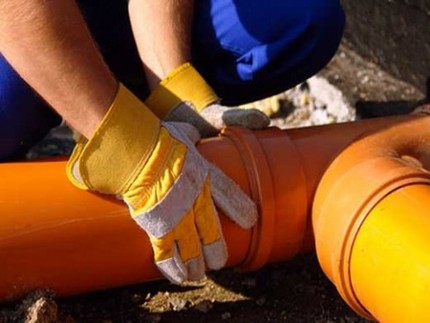
The two main components of polyvinyl chloride are ethylene and stabilized chlorine.
In order to improve the operational parameters of products during the manufacturing process, various additives are added to thermoplastic compositions.
Advantages and disadvantages of PVC products
Polyvinyl chloride after processing under the influence of high pressure at the outlet forms an ultra-strong composite compound. And therefore, products from this polymer have many advantages.
These include:
- Affordable cost. In comparison with concrete and cast iron analogs, the price of polymer products is relatively not high, which makes them affordable for any consumer.
- High performance. Corrosion does not form on the walls of polymer pipes. Products are resistant to aggressive environments. Due to the smooth inner surface, deposits are not formed on them and no growths are formed.
- Light weight products at a fairly high level of strength.
- Easy installationnot involving the use of special equipment.
- A wide variety of mounting elements. This greatly simplifies the design of branched complex pipelines.
Polymer pipes are frost resistant. So, with complete freezing, provided that there is no water in the pipeline, it does not even undergo cracking. The service life of polymer cylindrical products over half a century
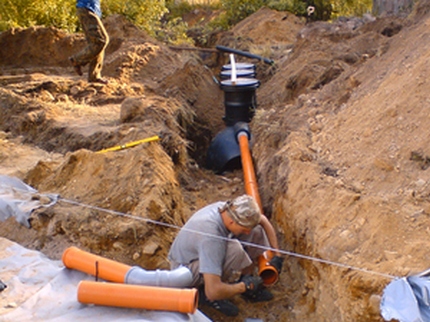
High rates of corrosion resistance give the go-ahead to installing polymer pipes underground. And this factor is key, since 90% of sewer pipelines run there.
With strict adherence to the installation technology, even when the groundwater level changes, polymer structures are not displaced in the area of the docking nodes, thereby minimizing the risk of system depressurization.
The only drawback of polymer pipes is their low resistance to UV rays and temperature limits from -10 ° C to +65 ° C. Direct contact with UV rays reduces product performance. In this regard, they lose to steel and cast iron counterparts, which ultraviolet can not cause harm.
Main types and sizes
Depending on the conditions of use, PVC pipes are available in three versions, which correspond to the main sizes:
- SDR51; SN-2; S25 series - products of light type are laid under the sidewalk, in the green zone and in places where traffic is not expected.
- SDR41; SN-4; S20 series - middle-type products are chosen for laying in places where the traffic is not so great.
- SDR34; SN-8; S16.7 series - heavy type products are chosen for laying in industrial areas and places with a saturated traffic flow.
Pipes used for laying external pipelines are single, double and triple-layered. In the latter embodiment, the inner layers of the product are made of foam material with a porous structure, which is obtained by recycling. And the top layer is made of primary unplasticized PVC.
The most common when laying on the street were two-layer corrugated pipes. The outer layer of such products has a corrugated surface with stiffeners. Thanks to this, the corrugation acquires increased strength.
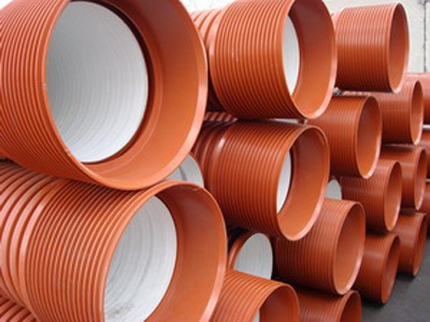
Both walls of profiled products are made simultaneously. Due to the fact that they are connected by the "hot" method, the finished cylindrical products are an integral design. The cavities formed between the inner and outer walls lighten the weight of the structure, and the wavy wall on the outside gives the necessary ring stiffness.
If we take the class of ring stiffness as the basis for the classification of polymer products, then PVC pipes are of three types:
- "L" - light pipes for laying in ditches, the depth of which does not exceed 0.8-2.0 meters.
- "N" - medium-hard products are designed for laying to a depth of 2-6 meters.
- "S" - rigid with a maximum wall thickness that can be laid in trenches up to 8 meters deep.
The parameter of ring stiffness of products is indicated by the abbreviation "SN". It is a significant quantity because it determines the initial deformation during laying and lateral support.
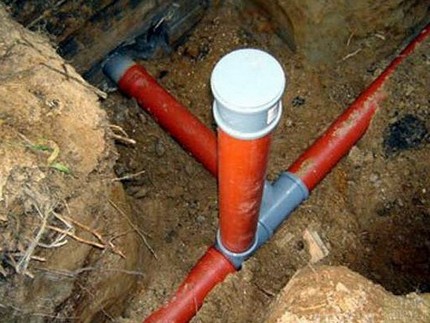
In systems involving forced drains, where pump equipmentinstall pressure PVC pipes. The basis for their manufacture is unplasticized polyvinyl chloride. PVC-U, which is famous for the highest possible performance.
The main difference between pressure pipes is that they can withstand significant loads on the walls. On sale there are three types of pressure pipes that can withstand pressure of 6, 10 and 12.5 kg / cm2.
In gravity-type sewer systems, the movement of wastewater is effected by gravity. For the arrangement of such systems, conventional PVC pipes are used, created on the basis of a simpler PVC polymer. The temperature range of these products is from 0 ° C to +45 ° C.
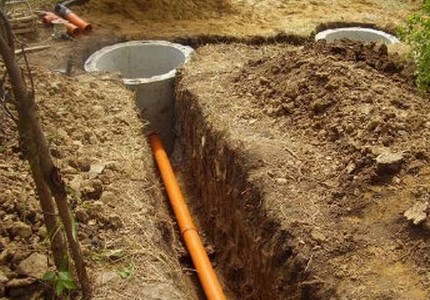
The size range of PVC pipes for outdoor sewage is also quite wide:
- 110 mm - products of minimum diameter are designed for the discharge of domestic wastewater in suburban construction.
- 315 mm - pipes of this size are used if necessary to build a common sewer system that unites several houses.
- 630 mm - pipes of maximum diameter are used for the construction of a general settlement sewage line.
Cylindrical products are produced in segments of 500/1000/2000/3000 / ... 6000 mm. Some sizes can be produced in twelve-meter segments. More about characteristics of PVC pipes we talked in this article.
Competent selection criteria
When choosing sewer pipes, they are guided only by two parameters: wall thickness and internal diameter of the product. The mechanical strength of the product largely depends on the wall thickness.
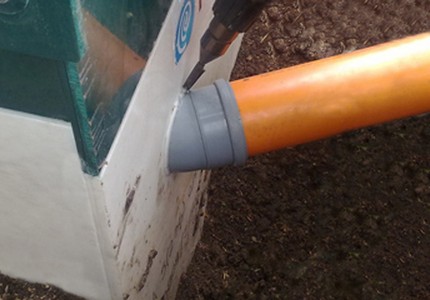
For internal sewage, PVC pipes painted in gray are used. When arranging gravity systems, the wall thickness of such products should be at least 1.8 mm.
For an outdoor gasket, which involves more stringent conditions, choose products in orange and yellow. In such products, each size corresponds to its own indicator of wall thickness.
As an example, we give the correspondence of parameters for pipes D 200 mm:
- SN2 - for light conditions with a depth of pipe laying within 2 meters, pipes with a wall thickness of 3.9 mm are selected.
- SN4 - for medium hardness conditions with a pipe laying depth of around 4 meters, products with a wall thickness of 4.9 mm are selected.
- SN6 - for severe conditions, with a pipeline laying depth of up to 6 meters, pipes with a wall thickness of 5.9 mm are used.
In addition to products of orange color for laying external sewage, you can use polymer pipes painted in red-brick color. Which sewer pipes do you prefer? This is the question we detail disassembled here.
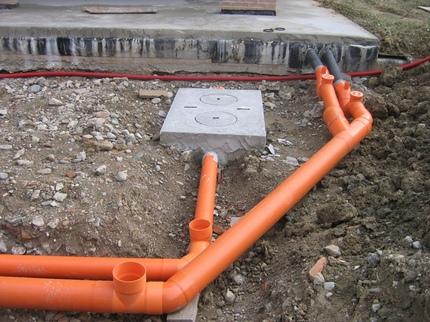
Corrugated pipes intended for external sewage have dimensions on the outer diameter in the range from 160 to 630 mm, and in terms of nominal diameter - from 139 to 542 mm. They are available in the form of six-meter segments. The ring stiffness parameter of the product is SN8 or SN16.
Difference of PVC products from other polymer pipes
Polyvinyl chloride is far from the only polymer used in the manufacture of pipes.
Along with it, these types of plastic are also used:
- RE polyethylene - plastic is used to create pipes designed to transport cold water.
- RE-S cross-linked polyethylene - polymer has temperature limits of the order of +95 ° C. And therefore it is used for both cold and hot water. It is famous for its resistance to mechanical stress and UV radiation.
- PPE polypropylene - characterized by good chemical and mechanical resistance.
- PVDF - semi-crystalline thermoplastic, which is famous for its resistance to the effects of a chemical environment. It is mainly used in the pharmaceutical industry for the transport of drugs.
- PB polybutylene - cross-linked polyethylene. It is produced in small quantities, because it is not very durable.
Many of the listed types of plastic pipes can compete with PVC products, but polyvinyl chloride pipes do not have competitors in terms of the range of advantages and the “price-quality” ratio.
Features of installing an external PVC sewer
Pipes made of polymer are famous for their ease of installation. To create a pipeline based on PVC pipes and fittings, no special tool is required. Yes, and work on the assembly and laying of the pipeline can be performed even by a novice master.
Methods of connecting products
PVC sewer pipes can be connected in one of two ways:
- Glue - involves connecting the elements by applying to the fittings a special adhesive composition.
- Bell-shaped - involves joining the elements by deepening the straight sections in the sockets, pre-treated with sealing compounds.
The adhesive joint, also known as cold welding, allows for 100% tightness.
With the adhesive mounting method, compositions are used that are methods of “welding” adjacent to each other elements at the molecular level.
When joining pipes with fittings, one end of the nozzle is coated with silicone grease and inserted into the socket until it stops. Joining elements is performed manually.
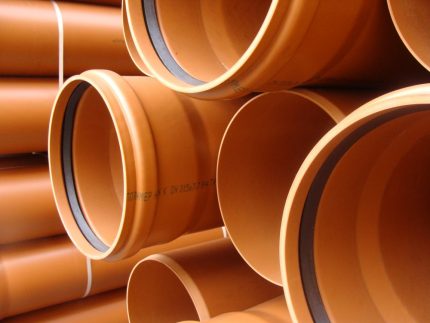
Basic laying rules
The key to the smooth operation of the sewer system is strict adherence to installation technology. And laying polymer pipes is no exception.
When constructing an external PVC pipeline, it is important to observe a number of basic rules:
- At the bottom of dug trenches, a cushioning "pillow" should be laid. Crushed-sand sanding will help protect the pipes from damage that may occur due to seasonal movements of the soil.
- Pipes must be laid downhill towards the intake manifold. The slope angle largely depends on the diameter of the pipes and can vary from 2 to 15%.
- If necessary, change the direction of the collector apply bends by 15-30 °.
- When laying the external pipeline, inspection hatches are installed for every 15 meters.
When backfilling a pipe laid in a ditch, the soil is tamped only from the sides. There is no need to ram directly over the highway.
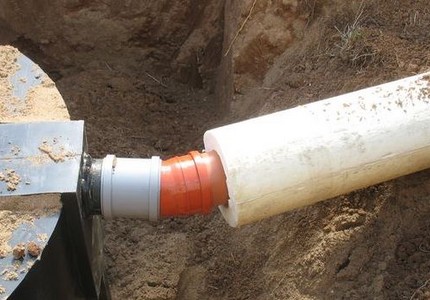
If it is impossible to deepen the polymer pipes to the required depth, they should insulate. This is especially true for products made of unpolymerized polyvinyl chloride, as they become fragile in the cold.
An important point: after the pipeline is insulated, it is necessary to re-measure the angle of inclination and, if it meets the norm, proceed with the final filling with earth.
In addition to choosing high-quality pipes for external sewage and their proper installation, it is equally important to choose the best pipes for installation internal sewer system and set in accordance with regulations and rules.
Conclusions and useful video on the topic
Options for sewer pipes and fittings:
Subtleties and nuances of installing a sewer pipeline:
With a competent approach to choosing products and observing the installation technology, the life of the pipeline will be commensurate with the duration of the "life" of the house itself.
Do you have an external sewage system made of PVC pipes and want to share your experience in installing and operating the system? Or maybe you noticed a mistake in the material presented or want to supplement our article with valuable comments and recommendations? Write your comments, ask questions, share your opinion in the block below.

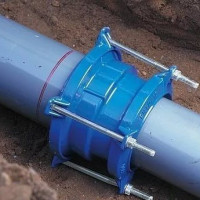 Cast iron pipes for outdoor sewage: types, features of application and installation
Cast iron pipes for outdoor sewage: types, features of application and installation 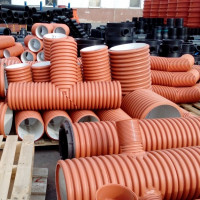 Corrugated pipes for external sewage: types, rules and standards of application
Corrugated pipes for external sewage: types, rules and standards of application 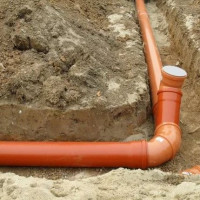 Sewer pipes for outdoor sewers: types and overview of the best brands
Sewer pipes for outdoor sewers: types and overview of the best brands 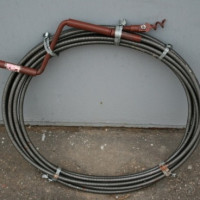 Sewer cleaning cable: types of tools and how to use them correctly
Sewer cleaning cable: types of tools and how to use them correctly  The smell from the sewer in the apartment: types of technical malfunctions and methods for their elimination
The smell from the sewer in the apartment: types of technical malfunctions and methods for their elimination 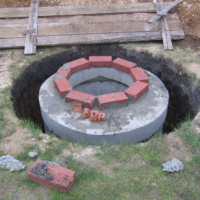 Concrete sewer rings: types, labeling, manufacturing methods + manufacturers overview
Concrete sewer rings: types, labeling, manufacturing methods + manufacturers overview  How much does it cost to connect gas to a private house: the price of organizing gas supply
How much does it cost to connect gas to a private house: the price of organizing gas supply  The best washing machines with dryer: model rating and customer tips
The best washing machines with dryer: model rating and customer tips  What is the color temperature of light and the nuances of choosing the temperature of the lamps to suit your needs
What is the color temperature of light and the nuances of choosing the temperature of the lamps to suit your needs  Replacement of a geyser in an apartment: replacement paperwork + basic norms and requirements
Replacement of a geyser in an apartment: replacement paperwork + basic norms and requirements
I live in a private house, I did the sewer myself. I dug a hole, put a dozen unnecessary tires from a truck of the same size. I dug a ditch half a meter deep. He laid a PVC pipe with a diameter of 100 millimeters, previously wrapping it with insulation, put a roofing material on top and buried it. And I inserted another into it, a smaller diameter of 50 mm. Maybe he did too much, but the design turned out to be simple and has been serving for the seventh year already.
The main disadvantage of PVC pipes is that they cannot be used at low temperatures, already at -15 degrees they already begin to freeze. In our latitudes, such a temperature is far from uncommon, so we have to deal with the insulation of PVC pipes. But this is not the only negative - there are still difficulties in connecting plastic pipes with metal ones. Often you have to connect through an American or other adapters, which is not always convenient. On the other hand, now everywhere plastic replaces metal and nowhere else to go.
So maybe in this case it is better to use PP pipes? They are slightly more expensive, but the temperature range of operation is much wider. But what are such pipes insulated with, or is the heating cable more practical for a private house here?
As for the characteristics of PP pipes relative to PVC, the former have superiority, given such qualities as:
1. The maximum temperature threshold;
2. Tensile strength, MPa;
3. The limit of resistance to bending, MPa.
For clarity, I will attach a table, but frost resistance is better for PE pipes. Regarding insulation, it is necessary to use special insulation made of mineral wool, polyurethane foam, foamed polyethylene or penoizol. But it is better to lay an external sewer pipe below the freezing mark of the soil, then insulation will not be needed.